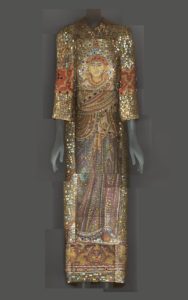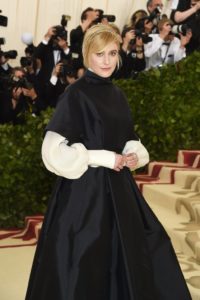The Met Gala
The “Optics” are over the top this week at Monday’s Met Gala. The bright reds in last week’s blog pale in comparison with the fashion statements in New York. But what are they saying?
Four young Catholic writers have weighed in the Gala, which is an invitation-only event hosted by Anna Wintour of Vogue to highlight – and raise money for, I assume – the Costume Institute at the Metropolitan Museum of Art in New York City. Rather than being highlighted, the exhibit, Heavenly Bodies: Fashion and the Catholic Imagination, got lost in most mainstream press coverage – but not for these four reporters.

Tara Isabella Burton in the “explainer” website Vox writes about the exhibit more than the Gala, and that’s a good place to start.The “Catholic Imagination” is represented by vestments and artifacts from the Vatican AND high fashion dresses by prominent designers. To give an example of what the show is like, in the room with the Byzantine collections of both the Met and the Vatican, my favorite dress is exhibited; it’s a glittery affair by Dolce and Gabbana that reminds me of Roman mosaics I have seen.
Burton connects the Catholic aesthetic of the “specifically religious” to pop culture by Catholic practitioners like Anne Rice and Madonna, and uses Andrew Greeley’s The Catholic Imagination to discuss sacraments and sex as integral to the aesthetic, quoting him to say that the Catholic “sees created reality as a ‘sacrament,’ that is, a revelation of the presence of God,” and says herself, “The ‘Catholic aesthetic,’ therefore, is often deeply erotic, examining the power of sexuality as a force for both good and evil.” Burton asserts that“Fashion is the perfect medium for the Catholic aesthetic;” it’s “all about both celebrating the human body and covering it up.” The gowns in the exhibit are beautiful, elegant, expressive, sexy. I was amazed and delighted.

In NCR, Claire Coffey might beg to disagree. She writes about the Gala rather than the exhibit, and finds – as no one else did – that “Greta Gerwig’s gorgeous, simultaneously austere and voluminous gown stole the show.” To Coffey, this dress “transcended the parodic register of the Gala” in recalling the Daughters of Charity and many other religious orders of women.

You’ll know what she means if you have seen the images of Rhianna, which were the star of the media coverage, at least.She was a glittery Pope in tiara, cape, and corset dress. Coffey concludes with a much more substantive analysis of the fashion industry and “how we dress ourselves,” way beyond “the tepid modesty-blogger cottage industry.” “Exhausted extravagance” is her final word on the Gala.
You probably expect something similar from Ross Douthat in the New York Times and he does not disappoint. “Beautiful and blasphemous” is his characterization of the Gala, where the entertainment was the Sistine Chapel Choir as well as Madonna and a Colbert/Kimmel duo. Douthat reflects, “When a living faith gets treated like a museum piece, it’s hard for its adherents to know whether to treat the moment as an opportunity for outreach or outrage.” He’d like to see the Church reclaim the “weirdness” of the “inheritance on display at the Met” rather than moving further into modernity, and he can’t ever resist criticizing Francis for ambivalence in this “debate.” Are these images of some of the Vatican artifacts “fascinating” for you? Part of your spirituality that you still miss? Remember, this show is only about fashion, not the whole Catholic aesthetic; music and architecture are not included.
In contrast, Eloise Blondiau in America celebrates the Gala as one who “interned at Vogue magazine while attending divinity school.” She admits that not all the engagement with Catholicism was “high quality,” but communicates most clearly the fun of the Gala and the effectiveness of the exhibit itself.
Yesterday I could not find a copy of the exhibit catalogue in Philadelphia, as I was so drawn into the art both of the designers and the Vatican. I will go to this exhibit, which is at the Met AND at the Cloisters (the Met’s jewel of medieval art up on the Hudson), with artifacts appropriate to each museum. The catalogue has articles by medievalists and art historians, and one by a Cardinal! Gianfranco Ravasi has written about David Bowie, among others, and heads the Pontifical Council for Culture. He is characterized by John Allen as an intellectual in the mode of William F. Buckley or Noam Chomsky (is that one mode?).
The concluding article is by theologian and priest David Tracy, who left Catholic University for Chicago after he and others disputed Humane Vitae. Much of his work is on pluralism and culture, a good match for this exhibit. In the excerpt in America, Tracy writes about artists as theologians: “Paradoxically, in some periods the leading Catholic thinkers are not the official theologians but rather the great artists. In the 16th and 17th centuries, for example, the most original Catholic theologians were the artists Michelangelo Buonarroti (1475–1564), Raphael, Leonardo da Vinci, Titian, Caravaggio and Bernini,” and Tracy goes on to discuss Michelangelo.
One final caveat. Does Fashion = Women? At the Gala, most men wore plain black or white suits, though Stephen Colbert’s had a kind of medieval figure in the fabric. Women were dressed as everything from angels to Joan of Arc, crosses to rainbows. (Thanks for the challenge to the official church from the LGBT community!) The items on loan from the Vatican are mostly priestly vestments and liturgical implements. What’s on loan from the designers is mostly women’s garb, inspired not only by religious art but also by monastic couture. No one asks the question of whether women belong in the “Catholic Imagination” beyond serving as nuns or as eye candy.

3 Responses
So interesting to hear about the various perspectives
on the gala. Like modern art, it was difficult to grasp all of the layered meanings, although ‘over the top’ was certainly one of them.
Gender shapes the world. Likewise, gender shapes the liturgy. The language of the human body is liturgical, but the human body is male and female. Therefore, the language of the liturgy is incomplete as long as it is exclusively male, because it suppresses the Sophia in ChristoSophia. It also suppresses further expansion of the “Catholic imagination,” and thereby becomes an obstacle to integral human development and an integral ecology. For your consideration:
An Integral Anthropology for Integral Human Development
http://www.pelicanweb.org/solisustv14n05page23.html
An Integral Anthropology for an Integral Ecology
http://www.pelicanweb.org/solisustv14n05page24.html
Everything is connected!
Really interesting. I hope you will give us your impressions of both settings of this exhibit. I don’t know if I believe in ONE ‘Catholic imagination’ but am very interested in what YOU see when you visit the Cloisters and the Met!